



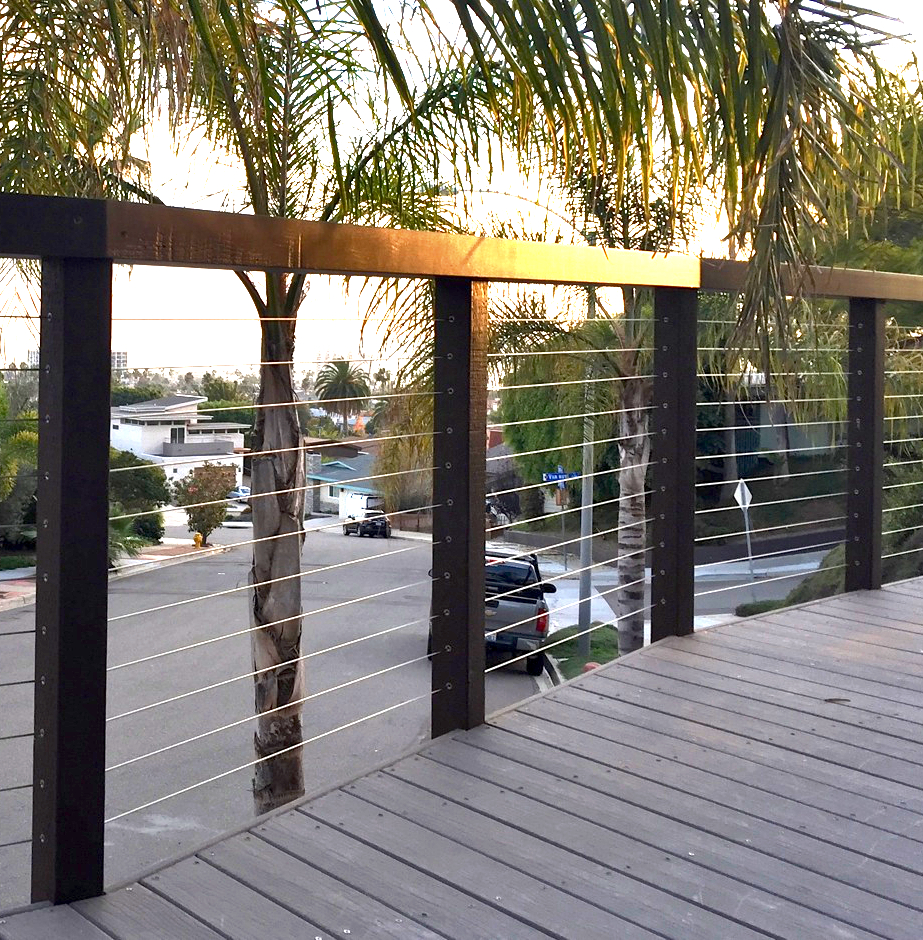
Infill Spacing for Safe Decks Building codes nationwide hold to a 4″ maximum clear spacing requirement for railing infill sections. Whether constructing new or retrofitting older barrier railings the code spacing requirement remains the same. By definition this means that no gap anywhere on the railing should exceed 4″ clear in between members. Older homes, condominiums, and commercial buildings with outdated railings may need to be upgraded in order to satisfy this requirement. Older code spacing (6″-8″) increase liability due to possible falls or injury caused by larger spacing requirements that could allow children through railing members. Newer codes and standards for child safety require tighter gapping. Safer deck railings utilize current codes with sturdy frames and max clear spacing of 4″. Cable rail spacing requires a max 3″ space to allow for deflection. Safer Decks Require Current Codes and Practices The 4″ maximum spacing requirement used for current codes was designed to prevent small children from being able to force their head or body into and through any gaps anywhere on the railing system. Safe railings are all about child safety requirements. In this article we will explore information necessary to upgrade your railing systems and make them safer for children, pets, and people. Railing Heights Vary by State Railing height specifications can vary by state and we recommend checking with current local building codes prior to construction. In California, a minimum railing height of 42″ is required. Other states like Arizona still hold to a 36″ railing height requirement. How to measure for finished railing height? Railing height should be measured from the top of the deck surface to the highest point of the top rail member. When performing site verifications our installers measure from multiple locations across the deck surface. Deck levels can vary, especially when dealing with slopes so it’s best to verify railing height in multiple locations. Vertical and Horizontal Rail Spacing Checking for voids along the railing frame is a good way to make sure your railings meet current codes. Safe deck railings should not contain any gaps larger than 4″. The following are common locations where these voids may occur: –Upright or Vertical Members – check spacing between pickets, posts, and or pipes, also check cables for 3″ spacing compliance –Horizontal railing members– bottom rails should be code spaced from the deck surface. Cable spacing should not exceed 3″ in order to prevent more than 4″ when deflection occurs. Solid members like pipe and/or wooden railing parts that do not deflect can be spaced at 4″ from center of member to member Glass infill – glass panels, lattice or solid wood, steel or other aesthetic panels should not have gaps larger than 4″ in between panels or scrollwork. Hiring Railing Pro to Construct Safer Deck Railings A large number of our customers hire a railing professional to guarantee safety and code compliance. Our preferred installers are licensed contractors; familiar with local and current code requirements. Some custom and higher risk applications like raised decks, balconies, and stairs greatly benefit from using pro’s. Our DIY products and solutions are very popular and easy to install however some applications are better suited for hiring a specialized contractor. HOA’s, and condo complexes are often required to use professional contractors for construction projects. Insurance claims also require the use of a professional. Large scale industrial projects, commercial, and retail spaces are best handled by licensed professionals. Our team at San Diego Cable Railings has been fabricating and installing code compliant railings since 2009. If you are interested in learning more please give us a call or visit the quote request page to receive an estimate. CLICK HERE TO SUBMIT A QUOTE REQUEST Cable Railing News Stair Railing Ideas MavenSeptember 6, 2024 Safe Deck Railings Pony Wall Railing Renovations MavenAugust 20, 2024 kids and cable railings, Safe Deck Railings Safer Deck Railings MavenJuly 31, 2024 deck railing costs Deck Railing Costs MavenJuly 16, 2024 glass railing posts All Purpose Railing Posts MavenJune 30, 2024 Browse More Posts

If you are performing a deck construction or renovation you might be wondering about deck railing costs for various deck railing systems. Railing cost can vary depending on layout and individual job specifics. Some of these specifics include the following: Job Specifics Related to Deck Railing Cost Lineal footage, material selection, deck elevation, framing and/or substrate materials and mounting options. A variety of other on site factors can affect the labor side of railing costs as well. At SDCR, we receive numerous phone calls asking for lineal foot cost estimates which are easier to do in certain situations. Deck railing costs are easier to ballpark on level rail non custom projects. Angles, waterproofing, custom requests, and salt exposure can make a ballpark costing more difficult. For budget preparation, the safest way to estimate a deck railing purchase and installation is to include as much detail during preparation as possible- (measurements, photos, stops, starts, stairs, transitions, etc.). Below are some common cost drivers for deck railing projects: Railing Frame Material Selection Wood framing like Cedar, Fir , and Redwood is typically the least expensive way to construct a solid deck railing frame. Wooden posts and rails can be sourced easily and often locally. For semi-skilled, or DIY installers, wood framing can be more forgiving to work with and less painful to the pocket book if a mistake is made. Mild steel framing or stainless steel is typically more expensive than wood framing. Railing manufacturers offer several different framing systems typically made from steel, stainless steel, or aluminum. Steel deck railing kits can be easy to install; however the materials are usually pre finished so mistakes can be more costly. Although the cost base is higher; stainless steel framing is likely the top choice among professionals for railing post materials. The cost can be offset by utilizing a wooden or hardwood top railing for a durable and cost effective railing frame. Deck Railing Lineal Footage Costs The more lineal footage on a deck railing project the lower the cost per foot should be. Both labor and manufacturing is largely related to set up and procurement costs so more is actually better in most cases. The larger the railing project and amount of lineal footage, the lower the actual lineal foot cost should be. Planning your deck layout properly can save thousands of dollars in the long run. Simple linear designs are often better than transitions and angles despite their simplicity. Smaller jobs like staircases can be expensive in relation to their size. Standard lengths are always beneficial to value engineering and lower overall cost. Stick to available lengths and minimize waste whenever possible. Labor Cost to Install Deck Railings Although some industry pricing standards exist; labor cost for installing deck railings will also vary depending on the individual project details. DIY deck railings, doing it yourself, can cut costs if the project can be completed successfully with professional results. Wooden deck railings, straight runs, and minimally elevated structures are good DIY candidates for first time installers. Cable railing kits are a great option for DIY deck railing projects. Custom railings, stairs, and on site fabrication or welding will usually increase the cost for installation; as well as the possibility of needing a professional installer. Hiring a deck and railing professional will usually be less expensive than making a mistake, or taking a chance on a professional with no fabrication experience. As modern railings like cable and glass become more popular, more options become available for materials and installers. Hiring a proven installer or specialty company can actually lower your deck railing costs by saving time or avoiding possible errors. If you have questions about our deck railing systems or would like an estimate for your project please visit the QUOTE REQUEST page and one of our railing pro’s will assist you.
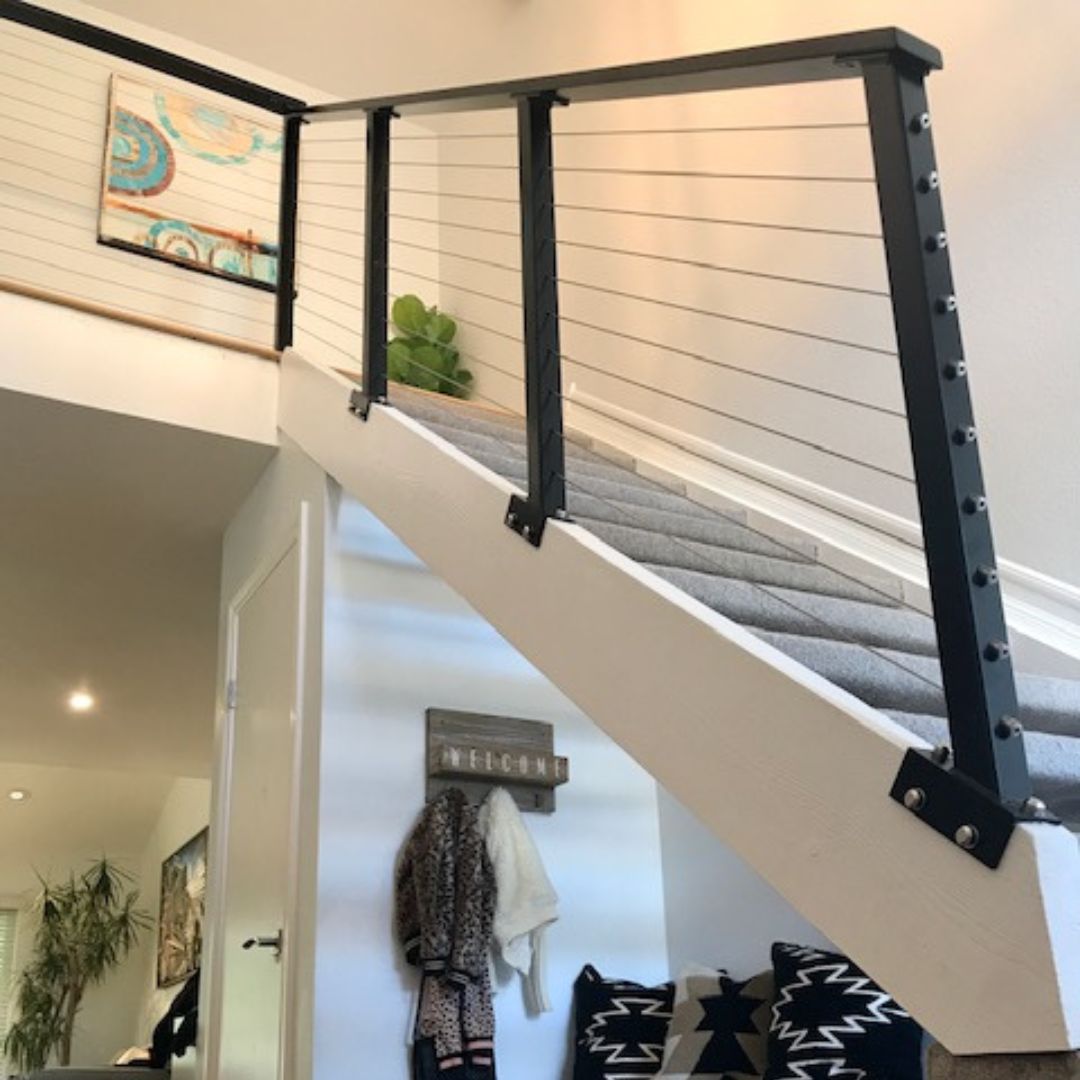
Safety railings can be found throughout your home to protect persons and pets from falls off raised surfaces. Whether it be an interior loft, exterior patio, or deck railing; the upright posts need to survive the test of time. On occasion and especially in older homes the railing posts will need to be replaced. This is a good time to consider price and function for the new products as well as total cost, maintenance possibilities and, longevity. Additionally, the aesthetics of the railing posts and/or new railing frame system will need to be considered as well. Considerations for future improvements like other fences and railings will be important as well. Numerous other articles contained within our blog have discussed material types and functions for different railing systems. This article explains and details our favorite post choice based on cost, versatility, and durability. All Purpose Steel Railing Posts for Cable Railing and Glass Panels San Diego Cable Railings multi purpose railing posts can be utilized for cable rail, glass clip, graspable rail and standard fencing applications. They come in standard sizes for both 36″ and 42″ railings and can be customized upon request. Posts can be purchased a la carte or included in a complete railing package. Usage examples for our steel and stainless steel multi purpose railing posts are as follows: Our customers and installers have utilized SDCR railing posts for the above listed applications and a multitude of other variations to include interior and exterior railing systems. Our posts are suitable for both commercial and residential applications. Engineered steel railing posts have passed hundreds of building inspections and can be found in hospitals, amusement parks, public businesses, parks residential homes and pedestrian bridges. They serve as one of the safest most versatile post options available. Fast Turn around Times and Nationwide Shipping on Railing Posts We believe our railing posts are some of the highest quality and most versatile railing posts available in today’s marketplace based on the most important metrics- safety, durability and price point. Few other products will compete or have been proven in such a wide variety of real world field tested applications. If you are interested in purchasing railing products for your next project; or have questions about which railing posts may be the right fit for you- give us a call at 844-277-7327 or visit the quote request form today. CLICK HERE FOR A FREE ESTIMATE
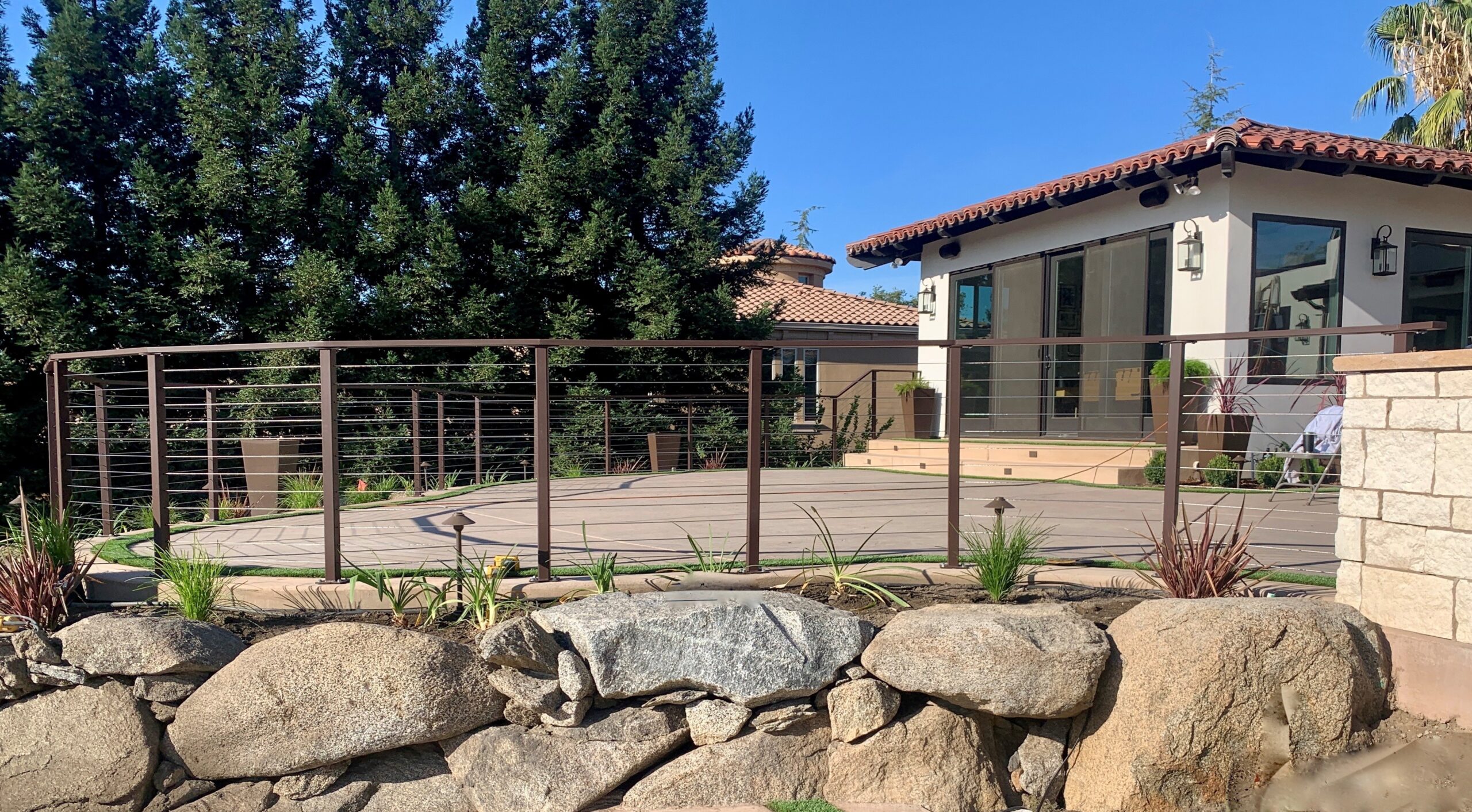
The most commonly utilized materials for constructing deck railings are metal, wood, and composite materials like Trex. Selecting the right material for deck railings can be a challenge with so many choices among the material types and preferences for safety and durability. Which type of wood is best? What type of metal should use for a coastal railing? Is stainless steel a better choice than aluminum? In this post we will answer these questions as well as some common questions regarding material choices for constructing deck railings. Top Choices for Metal Railing Materials Metal railings are arguably the most durable and widely utilized railing type available in today’s marketplace. Despite this durability, constructing a standard iron railing in the wrong setting or using the wrong metal combinations can have a detrimental affect on longevity. Our favorite material for constructing metal railings is stainless steel. Using similar metals like stainless frames combined with stainless cables will achieve the best results. Stainless steel is available in different grades for different levels of exposure. Type 316 stainless steel can be left exposed to the elements with a bare finish; standard iron railings can not. Iron will often rust when left exposed to the elements and almost always requires a coating for durability. When compared to aluminum, stainless steel is stronger and more attractive; allowing for leaner profiles due to its strength. Stainless railing frames require less components, grommets, and bushings when used in coastal settings. For modern railing infill like cable and glass panels, stainless steel is superior to wood, aluminum, mild steel, and rod iron railing systems. The price point for stainless steel is higher than many comparable materials; however the durability and longevity is superior. Best Wood Types for Exterior Construction Wood is widely used for construction projects and allows for flexibility as it is widely available. Wood can be stained or painted to achieve different looks and colors. Bare wood finishes are also popular and wood is relatively inexpensive when compared to most steel options. Some drawbacks to using wood framing for railing projects are maintenance requirements and durability issues related to insects and or dry rot fungus. Wood can be combined with steel and/or stainless steel to construct hybrid railing systems which offer a bit of cost savings and versatility when compared to all steel or all wood systems. For exterior structures with maximum exposure, hardwood species like Ipe’ will perform better than softer woods like cedar, fir, and redwood. Soft woods should be treated with penetrating oils, or painted for maximum durability. The price point for many wood species is better than steel and aluminum in most cases. Composite Products and Vinyl Railing Materials When it comes to low maintenance and use as a decking (flooring) material, composites are very hard to beat. They require much less up keep than traditional wood, rarely scratch or fade. Despite the ease to maintain, they lack the beauty and charm of natural wood and cost wise composite products can be very expensive. For years we have utilized composite materials as a capping material for wooden and steel sub rails to add durability or to color match decking material. For structural purposes and railing frames we do not utilize or recommend composite products. Structurally speaking, composite and vinyl materials do not measure up to steel, hardwoods, and aluminum railing frames. The amount of expansion and contraction during heat and cold make maintaining these railing types more difficult. Even the best fasteners can be sheared by this expansion and for this reason our top recommendation for railing material type is stainless steel. Vinyl fencing (non structural or load bearing) is durable and long lasting when utilized for perimeter fences, however we do not recommend or utilize vinyl products for constructing railing systems. San Diego Cable Railings and our preferred installation contractors have been fabricating and installing deck railings since 2009. Our steel, stainless steel, and wooden railing systems offer unmatched aesthetics and durability. We offer a full line of stainless steel railing posts, cable and glass railing packages, and preferred installation of the products in the state of California. if you have questions or would like to obtain pricing for interior or exterior railings please give us a call or visit the quote request page. CLICK HERE TO REQUEST A FREE ESTIMATE
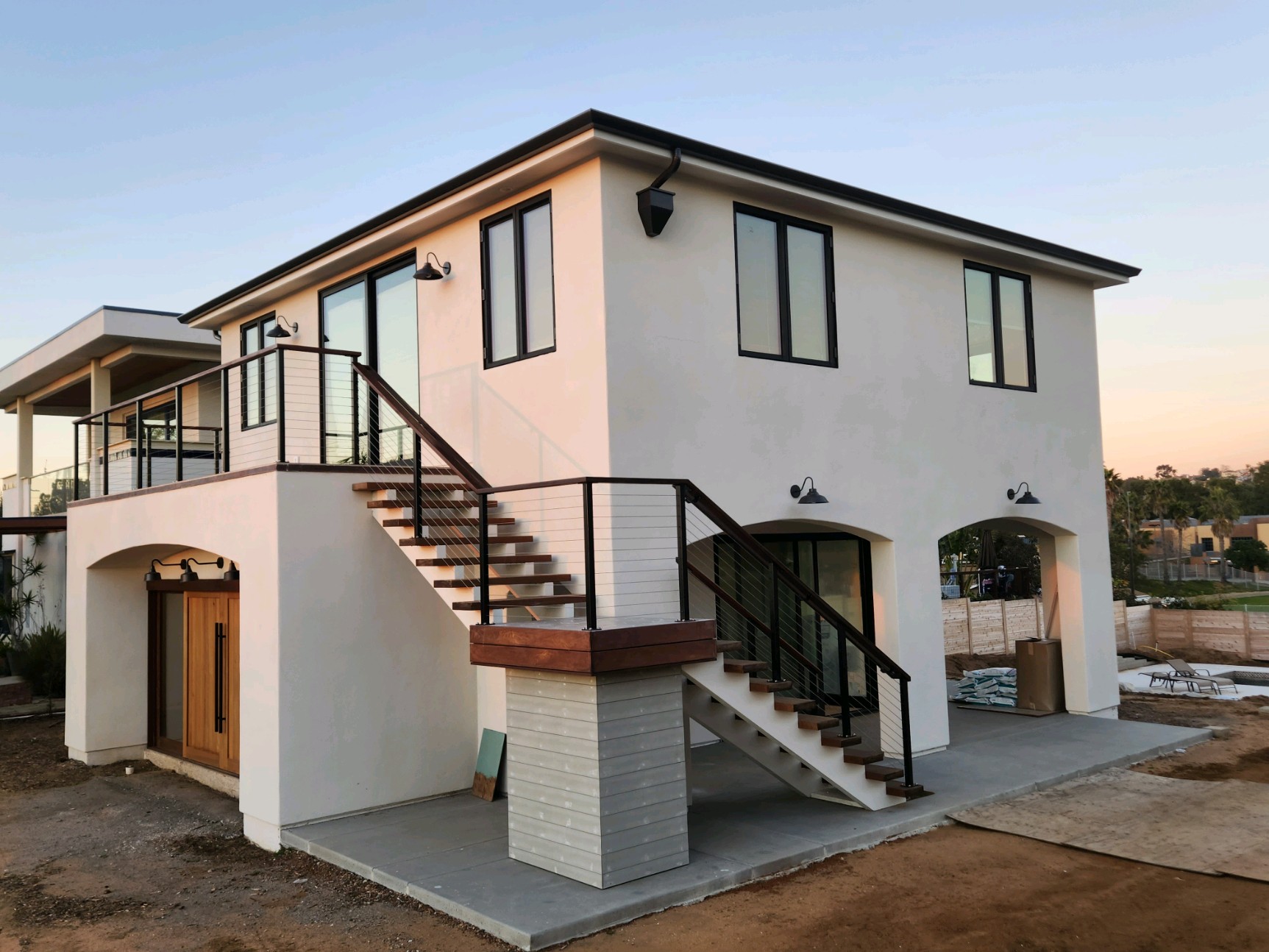
Accessory dwelling units or ADU’s are self contained single family dwelling units and they are quickly becoming one of the most popular building trends. Housing shortages and high cost of living have made these accessory units all the more desirable and many municipalities have even lifted restrictions and loosened zoning regulations to promote their construction. Although small in size; 150 – 1000 square feet; ADU’s are not tiny homes and the primary usage is as an additional dwelling on a single family lot; complimentary to a main residence. Pre-Fab Railing Packages for ADU’s Pre – fabricated and/or modular dwelling unit packages can simplify the construction process and some municipalities even have pre-made plan sets for accessory dwelling units. Pre-fab railing packages fit nicely into this scenario; also simplifying the process and allowing consumers to value engineer the build and streamline planning and preparation for construction. Cable railing systems and glass railing kits are great choices for ADU construction and here’s why: Lead Times- Modular and pre fabricated railing systems are often in stock and custom railing packages can be ready in as little as 2-4 weeks. Many of these railing systems are already engineered or approved for use in these type of structures. Stainless steel cable railings are versatile and can conform to almost any design standards; especially modern and contemporary styles used in many new structures. San Diego Cable Railings typical lead times for cable and glass railing packages are 1-2 days for pricing and 2-4 weeks for delivery. Pricing and Availability- A modular railing system like a powder coated cable railing kit from SDCR will price compete with any industry standard code compliant railing on the market. In addition, cable railing systems are extremely resistant to environmental conditions like coastal salt air. Availability for pre-made ADU railing systems is excellent, especially when choosing stock colors like black, white, brown, and metallic. Aesthetics- As seen in the images contained in this post, cable railing systems offer unmatched aesthetics for an ADU balcony, deck, or stairway. The clean lines and transparent railing infill are a perfect choice for almost any landscape setting. Cable railings have become a staple choice for interior stairs as well. Steel railing posts can be combined with hardwood species for a hybrid railing that ties into the look of hardwood floors. All wood cable railings can be selected for a warmer feel. All steel systems are a perfect look for sleek modern and industrial styles. Glass panels can be integrated into the railing frames for dining areas and windbreaks. Modern Railing Solutions for Modern ADU’s San Diego Cable Railings offers a full service experience for railing sales, design, and installation through our preferred contractors in California. Our company offers an engineered line of railing posts, perfect for permitted builds like accessory dwelling units. Our products can be utilized for cable and glass railing systems; and our licensed railing contractors are some of the best in technicians in the business. Give us a call today or visit the quote request form for pricing and availability. CLICK HERE TO REQUEST A QUOTE
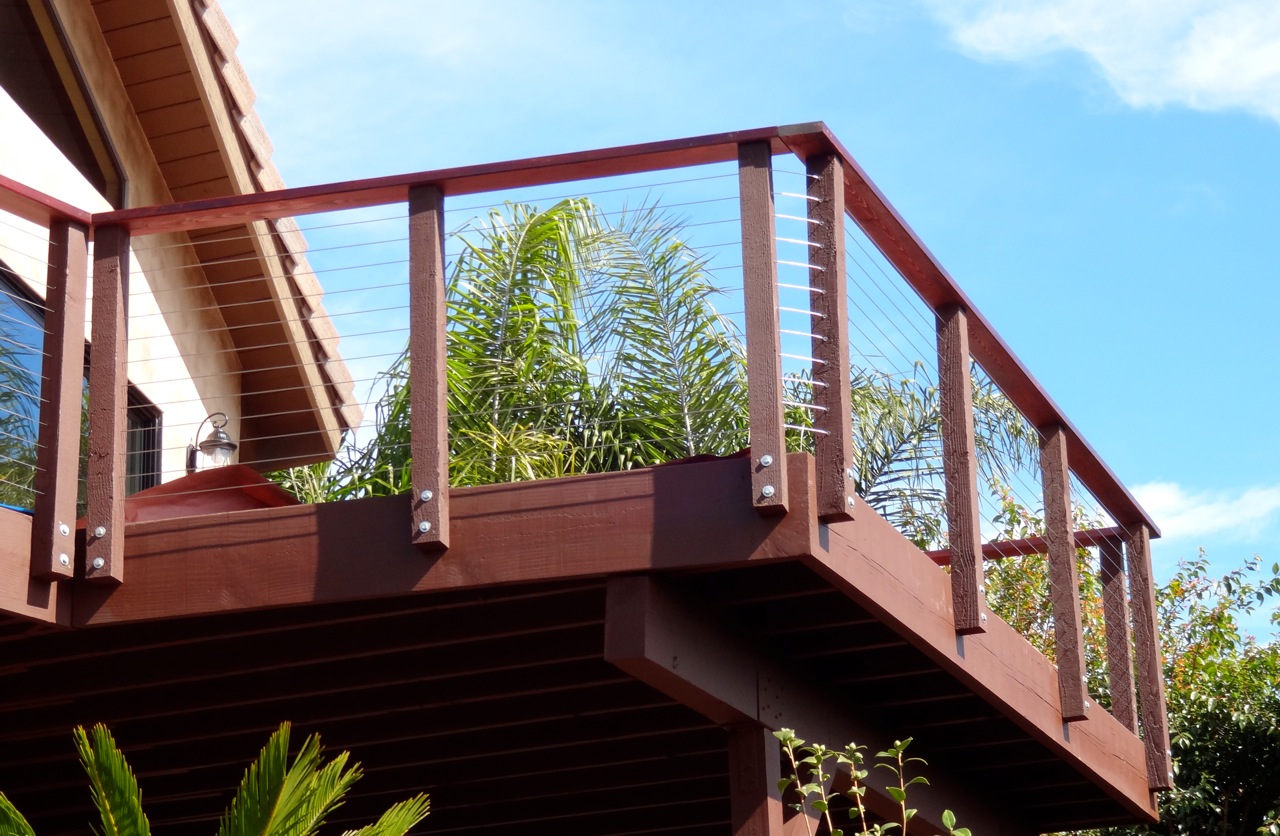
If you are planning to build a deck you might be wondering about the best height for deck railings in your area. What about ground level and low level decks? Do you need to construct railings at all? In this post we will review valuable information and these common questions about safe deck railing height. The post also contains information about utilizing deck standards, and how to determine what parameters might work for your project. From a legal standpoint different municipalities will require different guidelines however quite consistently we are referring to the height and spacing requirements for code considerations when dealing with residential deck projects. SAMPLE DECK RAILING STANDARD DRAWING: Using Municipal “Standards” to Calculate Railing Height One quick and accurate way to start the deck design process is to locate the ” deck building standards” for your area. Standards are often used in lieu of engineering and can streamline the permitted building process. When dealing with deck standards we are usually referring to some common factors that might include: Footing size and depth Joist and beam or girder sizing Railing type, height, spacing, and lateral loading requirements By following a city standard design document we can eliminate certain variables and construct something that falls within the standards to bypass engineering or possible delays with building departments. Typically if a design doesn’t satisfy standard requirements an engineer will be needed to provide calculations for callouts that do not meet the standard requirements. An example of a common requirement that would require an engineer for deck design: The desire to span a beam of any size further than 10 feet. This span does not fall within the standard requirement and therefore requires an engineered calculation to prove safety and stability. Standard Railing Heights by Area Building codes for single family residences often refer to the “IRC” or International Residential Code. This is a set of simple guidelines used to protect public safety and the requirement for railings is enforced on decks above 30″ from grade. In most states and many other places the residential guardrail height is 36″ high minimum. In California the minimum requirement is actually 42″ height. How do I calculate railing height? – railing height is calculated by measuring from the deck surface to the top of the rail. When pre planning or dealing with different decking substrates like tile, texture deck, composites, etc. it is important to facto in the thickness of the substrate into the railing height. Additionally, if you plan to recess railing posts inside the deck or utilize a pre-made railing package these factors will affect the overall railing height. Pre-made railing systems like these are an excellent choice for residential decks. Deck Railing Spacing Requirements Balusters, pipes, cables, panels or any other form of infill for your deck railing must follow specific guidelines in addition to the height requirements. Almost universally there is a maximum spacing of 4″ allowed in between balusters or solid members. Infill options like stainless cables follow a tighter guideline of 3″ spacing not to exceed 4″ upon deflection. The main reason for this spacing requirement is to prevent babies and small children from forcing their way through the railing infill. San Diego Cable Railings produces a solid and attractive collection of railing systems for both DIY and professional clientele in 50 states. Our products have passed countless inspections and our preferred installers have successfully completed thousands of projects since 2009. If you have questions about the best height for deck railings in your area, or would like to obtain a quote for deck railings please give us a call or visit the quote request page for pricing.

Code Compliant Clear Spacing Building codes nationwide hold to a 4″ maximum clear spacing requirement when it comes to constructing new or retrofitting older barrier railings. More simply stated; this means that no gap anywhere on the railing should exceed 4″. Older homes, condos, and apartment buildings with outdated railings may need to be upgraded due to this requirement. Being grandfathered in at an older code spacing requirement may not prevent liability due to possible falls or injury caused by outdated spacing requirements. Newer codes and standards for child safety railings require tighter spacing than standards from decades ago. What’s the reason for newer and tighter spacing requirements? The 4″ max spacing requirement used for current codes was actually designed to prevent small children from being able to force their head or body into and through the gap anywhere on the railing framework. It’s been this way for some time now and it really boils down to child safety requirements. In this article we will share some information necessary to upgrade your railing systems and make them safer for children, pets, and people. Code Railing Height by State Railing height considerations can vary by state and it is recommended that anyone considering new railing construction or retrofit check with local building codes prior to installation. In California, a minimum railing height of 42″ is required. Some states still hold to a 36″ railing height requirement. How do I figure out my railing height? Railing height should be measured from the top of the deck surface to the top of the railing cap member. A good rule of thumb is to measure from multiple locations to ensure uniformity across the surface. Decks and patios can vary, especially when dealing with slopes so it’s best to check height in multiple locations. Railing Gaps, Vertical and Horizontal Member Spacing Checking for gaps along the railing framework is a good way to make sure your railings meet current codes. Child safety railings should not contain any gaps larger than 4″ and there are common locations where this may occur: –Vertical Members – check spacing between pickets, balusters, and or vertical pipes, cables for compliance –Horizontal members– bottom rails spaced from deck surface, horizontal pipe or cable spacing. Cable spacing should not exceed 3″ in order to prevent more than 4″ when spread. Solid horizontal members like pipe and/or wooden railing members that do not move can be spaced at 4″ clear –Panels– glass panels or solid wood, steel or other panels should not contain gaps larger than 4″ in between panels Hiring a Professional for Safer Railings Many people choose to hire a deck builder or railing professional to guarantee safety and code compliance. Hiring a licensed contractor that is familiar with local and current code requirements is a good option for higher risk applications like raised decks, balconies, etc. DIY products and solutions are very popular and effective but there are also applications that are better suited for hiring a professional installer. High rise multi unit complexes, HOA’s, and municipalities are often required to use professional contractors for construction projects. Additionally, insurance claims often require the use of a professional. From a railing application standpoint; stairs, angled applications, large scale projects, commercial, and industrial projects are best handled by licensed professionals. Our team at S.D.C.R. has been fabricating and installing child safe, code compliant railings for nearly 2 decades now. If you are interested in learning more please give us a call or visit the quote request page to receive an estimate. ADA Compliant Railings, Architecture test post MSimontonApril 2, 2024 Cable Railing News, kids and cable railings Child Safety Railings MavenMarch 28, 2024 cable railing code, Cable Railing News Height Standards for Deck Railings MavenMarch 5, 2024 Stainless Steel Cable Railings Choosing the Right Stainless Steel Cable Railing for Your Deck Cole RouseJanuary 24, 2024 Stainless Steel Cable Railings Why Stainless Steel Railings Are a Safe and Sleek Design Option Cole RouseJanuary 24, 2024 Browse More Posts
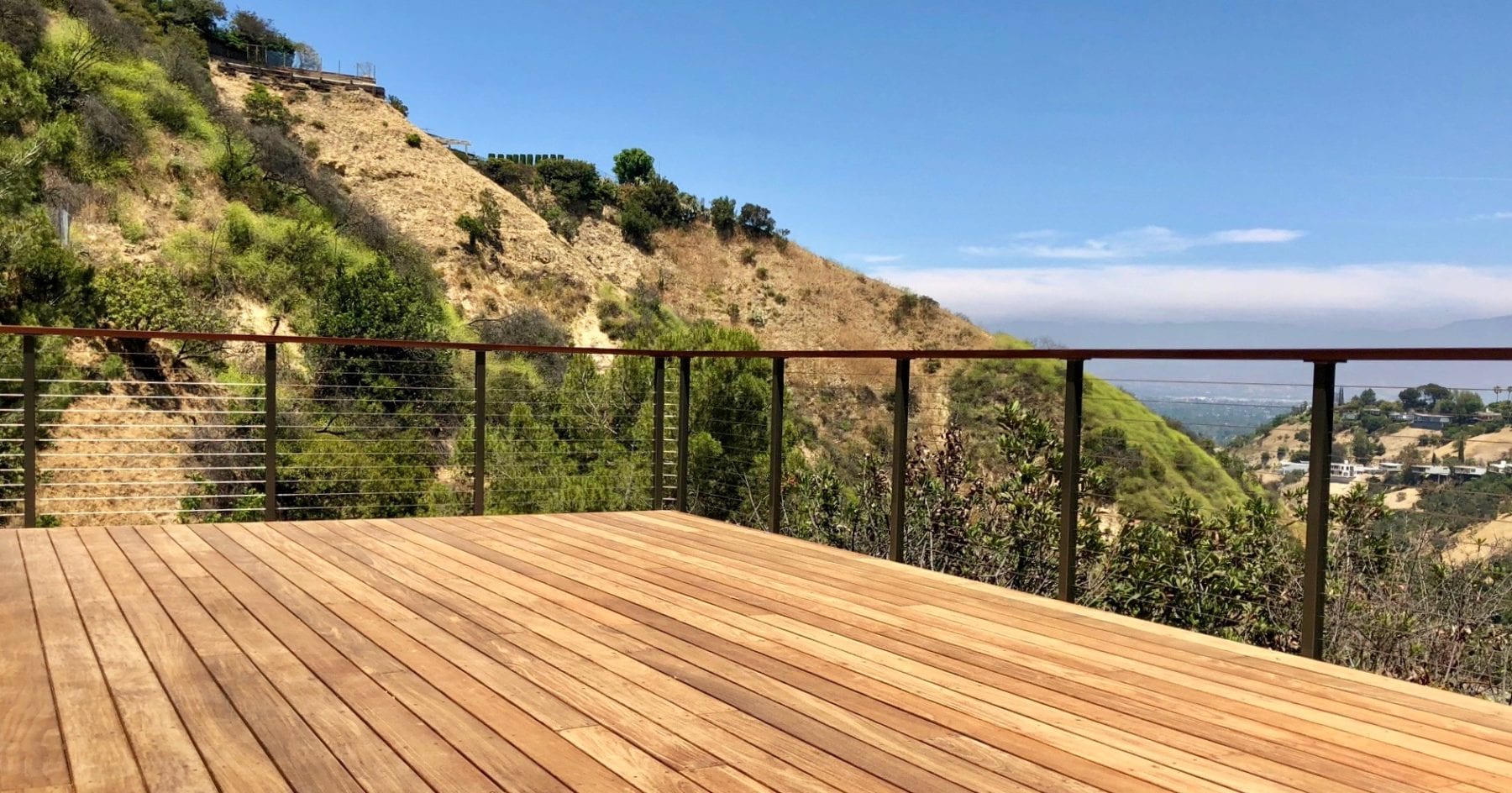
Standards and Code Considerations for Railings on Raised Decks Whether you are building a wooden deck, concrete patio, staircase, or an interior loft; your project will involve the construction of barrier railings. A barrier railing is designed to keep persons and pets safe by providing a “barrier” to prevent falls from a raised surface. Building standards and codes for railings have evolved over the years, mostly becoming more stringent for safer railings. Included in this post are some of the most common considerations for constructing a railing system on a raised deck or patio: Railing Height Code Requirements The majority of states in the U.S. require a minimum barrier railing height of 36″ from the top of the substrate (deck surface) to the top of the railing cap. Commercial projects often require a railing height of 42″ for an added factor of safety. Railings in California whether residential or commercial require a finished railing height of 42″. Stair railings require a minimum barrier height of 36″ and also the additional safety factor of a graspable railing or “grab rail” between 34″- 38″. A top railing can double as a grab railing in certain scenarios; the main consideration here is that the top railing is graspable. A graspable railing must be small enough for even a small hand to wrap the entirety of the member; often this means no larger diameter than 1.5″-2″ and not more than a 6″ perimeter measurement for the rail. Deck and Stair Height Standards for Railing Construction There are standard platform heights for when railings are required to be constructed on raised structures. The most common call out is a 30″ above grade height requirement. A common industry misperception we encounter is that a low level structure does not require a railing; or that a non code compliant railing can be constructed under a certain deck height. Code compliant deck railings are required to be constructed on any surface higher than 30″ from natural grade, including stairs. This is typically referring to natural or native grade; meaning bringing in fill to raise the grade may not satisfy the requirement. Stairs containing more than 3 risers (in some cases any stair set) are required to have railings. Additionally, when constructing railings on any raised surface (even under 30″) or retrofitting existing railings; the new railings are required to be constructed to current codes and building standards. In all cases, we recommend checking your local municipalities. Additionally, we recommend that homeowners understand that building inspectors have ultimate discretion on site if they believe something is substandard or unsafe. Standards and codes are often up to the interpretation of municipalities and their representatives or inspectors. Regulation Height for Porch Railings Construction of porch railings falls under the same regulations and standards that apply to deck railings and stairways. Although porches are often only a few steps high, they are highly trafficked and serve as raised entryways to residential homes. A porch that is at least 30″ above grade will require the same barrier railing standard as a raised deck of this height. Porch stairs should have barrier railings and also graspable railings to accommodate high traffic and often the use of young and elderly people who may pose a higher fall risk. Modern railing systems like cable railings and glass railings are an excellent choice for safety, durability, and a beautiful aesthetic. San Diego Cable Railings offers pre-made railing packages that satisfy height standards for deck railings at 36″ or 42″ requirements. Our railing posts are engineered for safety and longevity with welded connections, durable stainless steel, and heavy duty coatings. Visit the quote request page or give us a call to learn more and build a code compliant railing system for your home today. Quote Request
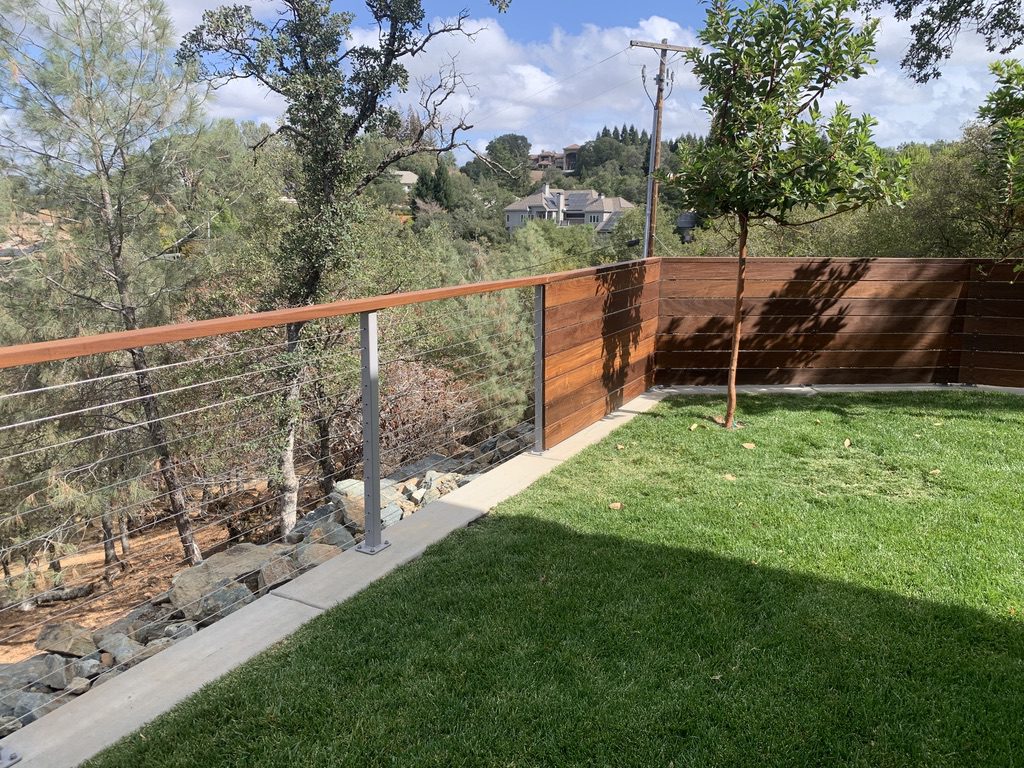
A railing system that mixes and matches components or different building media is referred to as a hybrid railing system. This can be as simple as a steel post cable railing system that utilizes a wooden or composite cap. Another example of hybrid railing would be including multiple types of infill on a single installation. For customers exploring hybrid railing options or wondering about the benefits of installing a “mix and match” type system; here are some examples of how this can benefit your project: Hybrid Material Selection for Cost Effective Deck Railings One of the easiest ways to save money on any remodeling project is by selecting cost effective materials or value engineering the project. Cable railings are some of the easiest systems to modify and hybridize because they are so versatile. By simply selecting a wooden frame to support stainless cable infill, you can create a hybrid design that will cost less than an all steel system. Another example would include the use of a wooden or composite top rail combined with steel posts and cable infill. Similar configurations would also work with glass or pipe infill and utilize cost effective framing to lower the burden on more expensive materials like glass and stainless steel. Selecting wooden graspable rails (grab rails) to combine with steel brackets would provide cost savings in comparison to an all steel graspable railing. Glass Panels and Cable Combination Railing There are several reasons to examine the use and/or combination of glass and cable on a single installation. Cost could be one factor, but the repeated example we encounter is when there is a need for windbreak on a section of deck but not on the entire deck. Glass panels are transparent and beautiful to the eye; they also make an excellent wind break. A customer in the market for the aesthetics of stainless cable that also wants wind protection can choose a hybrid cable/glass system to achieve both goals. The hybrid railing in this case will serve multiple uses, likely cost less than all glass, and be interesting to look at. Both systems provide transparency and beauty, while the cable portion will require less frequent cleaning and cut down cost. Hybrid Railings for Aesthetic Purposes Roughly 50% of our railing kits and installations are now performed on the interior of our customers residences. Homes of all different ages and styles make perfect candidates for hybrid styling. One example could be a home with an existing oak hardwood floor and a customer that is looking to remodel their staircase. By simply fabricating a wooden top rail made from similar oak; a hybrid railing will tie in the old with the new. In this example a solid steel or stainless system may not work with the design and the older flooring but the hybrid railing does a great job marrying the two. The glass with cable combo can also work on the interior sections of homes where a loft will require glass but the staircase will be done in cable. Hybrid combos work great with older homes that do not require ultra modern or contemporary finishes. Design combinations and possibilities are endless with multi purpose railing posts and mix/match infill options like stainless cable and glass. Our company has designed and supplied hybrid railing combos for customers nationwide. If you are interested in obtaining a quote for hybrid railing visit the quote request page today.
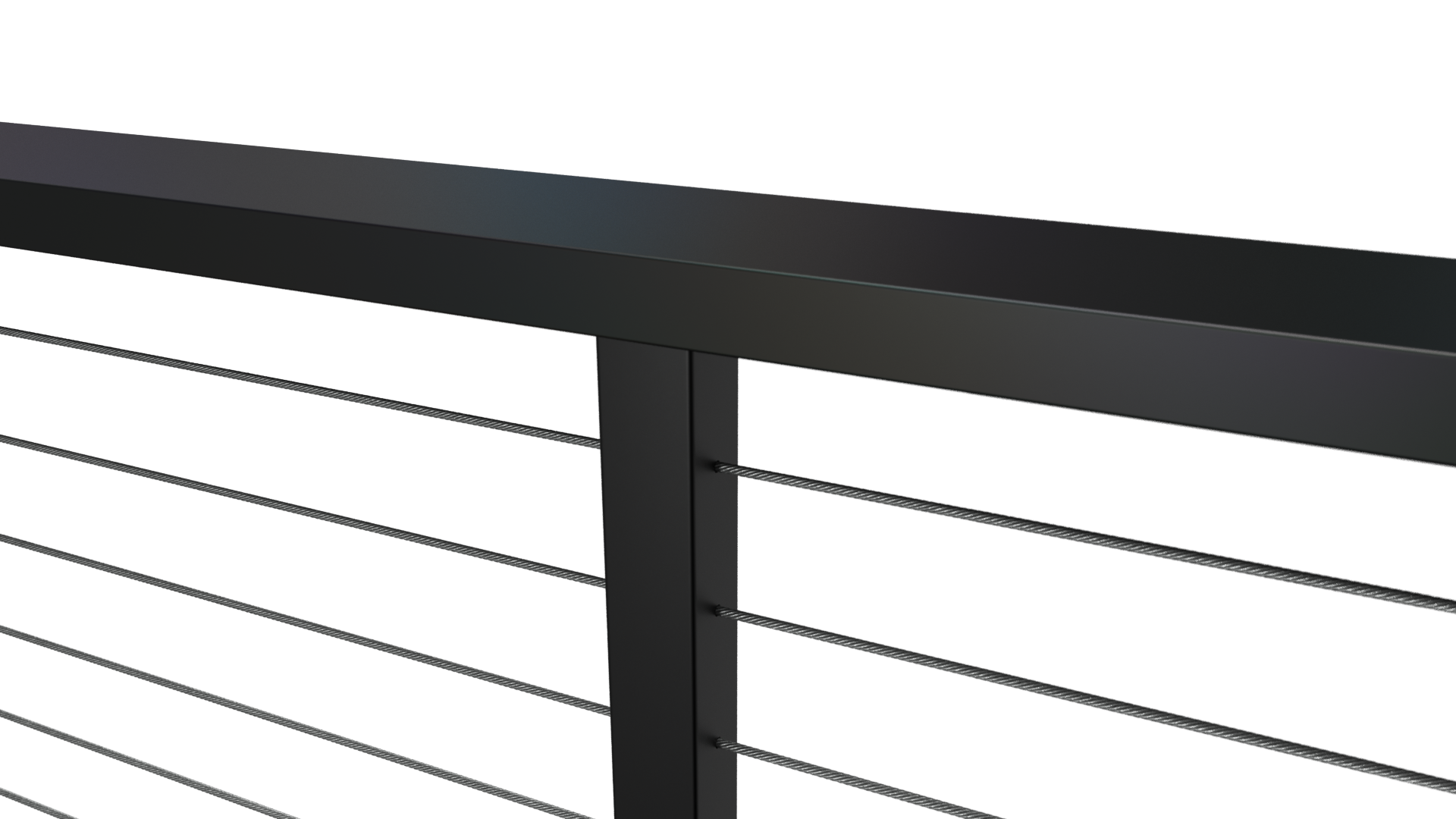
There are several types of interior and exterior railings and railing post types available in today’s marketplace. Reviewing the different mounting types, recommended spacing, materials, colors and applications can be daunting at times. In this post we aim to clarify some of these details and offer some common terminology regarding the most popular railing post types. Most of the reference material is geared towards stainless steel cable and glass railing systems as those make up the majority of our sales and installations. Structural Railing Posts Depending on the type of railing system there may be a single type or many type of posts used to support the infill and top rail. Structural posts refer to those designed to sustain lateral and possibly tension loads within a railing system. An “end post” or a “corner post” within a cable railing system refer to structural railing posts. In comparison, a “spreader post” would not be considered a structural railing post as its purpose is not primarily structural and mainly aesthetic. A common spacing recommendation for structural railing posts is between 4 and 6 feet on center spacing. Cable railings require tighter spacing for structural posts than picket railings due to tension loads and spread. The most common recommendation for cable railing systems is 4′ on center, while glass panels might be 5′ on center, and various picket or rod infill systems can push to the 6′ on center spacing. These are generic guidelines as systems and municipalities vary. Installers should follow recommendations and current codes. Glass Boot and/or Base Shoe Support Systems Although not technically a railing post, base shoes are becoming more and more commonly used for glass railing systems. A “base shoe” or “boot” is secured to the deck surface and acts as a structural clamp and support for heavy duty tempered glass panels. Structurally, a boot system is one of the only secure ways to support glass panels without the use of railing posts. Base shoes are engineered for structural use and support, requiring grout or a special locking system to secure the panels and support system. Recent updates have called out the use of laminated glass more and more often for “no top rail” glass systems. A base shoe mount is a proven way to safely achieve this type of install. Railing posts of different types and sizes can also be used in lieu of base shoe for installing glass panels. Typically glass clips (small clamping mechanism) are attached to structural railing posts in order to secure glass panels for this type of installation. Additionally, there are full framed glass systems which utilize channel and/or full framed glass railing with top and bottom railings and structural posts every 4-5′. Intermediate Posts, Spreader Posts, and Slim Line Railing Posts Intermediate posts like the one photographed above are also called “spreaders” or “line” posts. This type of railing post is often utilized to increase a viewing window without the larger profile of a structural post. As photographed the structural posts are 2″ square while the spreader post is a mere 3/8″ wide profile. The intermediate (spreader) post provides some rigidity and prevents the stainless steel cables from spreading, without the need for the heavy wall or width of a 2″-4″ post. When dealing with cable railings, glass, and other low visibility systems; spread is key to opening the view. When utilizing spreader posts between structural posts, installers can achieve clear windows of 6-7 feet without fear of code compliance or stability issues. Additional Notes on Railing Posts and Terminology Consumers should note that railings and fencing are very different when it comes to spans and spacing. There are many photographs found online that illustrate posts, pegs, clips, and all different kinds of spacing that may or may not satisfy code requirements for a safety railing. Just because photos exist, does not mean it will satisfy an inspection. Windbreaks and fencing may not require the same safety measures as a second story deck. Railings with and without top railing members will often have different rules and code requirements. Our company (San Diego Cable Railings) has been furnishing railing kits to homeowners and builders nationwide since 2009. We furnish a variety of railing posts for cable, glass, rod, and horizontal panel systems. Our welded connections and high grade stainless posts have been engineered to satisfy loading requirements, and even our spreader posts provide unmatched strength and elegance for your home. If you have questions about any of our railing post types or would like to obtain pricing for a railing system, give us a call or visit the quote request form today.